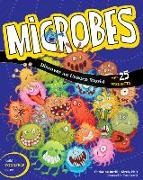Ulteriori informazioni
An introduction to microorganisms with instructions for twenty-five projects.
Sommario
Introduction: A History of Microbes
Chapter One: The World of Microbes
Chapter Two: Microbes in Food and on our Bodies
Chapter Three: Microbes in Water
Chapter Four: Microbes on Land
Chapter Five: Microbes on the Dark Side
Chapter Six: Our Fight Against Pathogens
Glossary
Resources
Index
Info autore
Dr. Christine Burillo-Kirch earned a Ph.D. in Microbiology & Immunology from the School of Medicine at UNC-Chapel Hill. She has conducted scientific research in bacteriology and immunology for 12 years and has been published in several peer-reviewed scientific journals. Christine lives in Cary, North Carolina.
Tom Casteel is an illustrator and cartoonist with a master's degree from the Center for Cartoon Studies. Tom has illustrated several books for Nomad Press, including
Natural Disasters: Investigate Earth's Most Destructive Forces;
Cities: Discover How They Work; and
Explorers of the New World: Discover the Golden Age of Exploration with 22 Projects. Tom lives in South Bend, Indiana.
Riassunto
If our vision improved one million times, we would be able to see microbes in the air, on our skin, in the soil, in water, and on food! In Microbes: Discover an Unseen World, readers journey through microscopic worlds that collide with our own on a daily basis to encounter bacteria, viruses, fungi, protists, and archaea.
There are some microbes we can’t live without, such as those that help us digest our food, while others can harm or even kill us, such as influenza and ebola. Microbes looks at some of the ways the body protects itself from diseases and infections through critical thinking exercises that explore the differences between harmful and beneficial microbes. Follow in the footsteps of the scientists who had both the genius and the imagination to research and discover microbes.
Hands-on experiments such as building a mini incubator, making bacterial growth plates, and growing fungi allow children to explore their microbiological surroundings safely while employing the scientific method to discover details about microbes. Fun facts and primary sources make learning fun and integrative, while cartoon illustrations engage kids' imaginations and prod their natural curiosity about this weird and fascinating topic.
Testo aggiuntivo
Puget Sound Council for the Review of Children’s Media: Highly Recommended -- Superior book everyone should buy.
This is the ideal book for students who want to know more about microbes than they are learning in the classroom. Part textbook, part experiment project book, colorful, fun, and animated Microbes is easy to follow and goes in depth into various parts of the science: the scientists behind discoveries of microbes, illnesses and disease, and cures and antibodies. Each chapter has an essential question that is written both at the beginning and the end. Students are encouraged to reflect on what they have learned by keeping scientific journals (the scientific method is spelled out as well). At the end of each chapter are three different experiments that children can perform on their own (if there is any potential danger, the author notes that parental help is advised). Several QR codes are available so the reader can take a closer look at a microbe, pathogen, etc. Table of contents, index, resources used to write this book, recommended web sites and books, metric equivalent chart, and QR code index (in case the scanner does not work) all serve to round out the amazing science book!”

